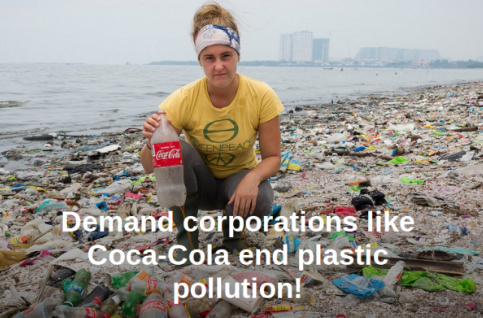Who could have thought when we were growing up that soda pop would become a major water and environmental issue.
Last year, Greenpeace launched a campaign to get Coca Cola, Inc. to cut back on their use of single-use, throw away plastic bottles. Louise Edge, Senior Oceans Campaigner for Greenpeace, said “As the biggest plastic bottle producer, Coca-Cola has a special responsibility to lead the way in reduction of single-use plastic. The massive increase in plastic waste in our oceans, and increasingly in our food chain, is a result of our dependency on throwaway items like single-use plastic bottles”. According to Greenpeace, Coca-Cola produces over 110 billion throwaway plastic bottles every year – 3400 per second. Single-use plastic bottles now make up almost 60% of Coke’s global packaging, up 14% from 2008-2016. Coke set a target in 2013 that its recovery & recycling rates in developed countries would rise to 75% by 2020, but actual rates declined from 63% in 2013 to 59% in 2016. Most recently on 19 January 2018, Coca Cola released its new Global Plastics Plan. Greenpeace denounced the plan as being weaker than those previously announced for Europe, and because it failed to include any reduction of the company’s rapidly increasing use of single-use plastic bottles. Read more at – Greenpeace slams Coca-Cola plastic announcement as ‘dodging the main issue’ , and Fact sheet about Coca Cola’s bottle polution.pdf.

Coca Cola, and indeed all of the soft drink industry, has experienced a loss of market share in the last decade, mostly to bottled water. Sales of soft drinks has fallen every year since 2006. Derek Thompson of The Atlantic explained that the three soft drink “jobs” are now satisfied by other beverages. Growing numbers of people get their hydration from water, their energy jolt from coffee and energy drinks, and their fizzy fun from flavored seltzers, like LaCroix. Since 2000, bottled-water consumption has tripled – Diet Coke’s Moment of Panic. While the switch from sugary soda pop to water is a welcomed health improvement, the continued and growing use of single-use plastic bottles in no improvement at all.
A report from the Earth Institute of Columbia University noted that “In 2014, Americans discarded about 33.6 million tons of plastic, but only 9.5 percent of it was recycled. Most of the rest ends up in landfills where it may take up to 500 years to decompose, and potentially leak pollutants into the soil and water”. It’s estimated that there are already 165 million tons of plastic debris floating around in the oceans, including microplastics, tiny particles less than five millimeters long that harm or kill the marine wildlife that ingest it. A team of scientists from the University of Georgia, the University of California, and Sea Education Association calculated in 2017 that from 1950 until today, humans have generated 8.3 billion metric tons of plastics of all kinds. They confirmed that only 9 percent of it was recycled, while 79 percent was landfilled or else polluted the natural environment – Scientists calculate total amount of plastics ever produced.

A key observation by the scientists is that plastics’ largest market is packaging, and most packaging is used once and discarded – such as single-use bottles. Plastics, of course, are petroleum, which carries it’s own ecological liabilities of drilling and tar sands mining, of pipelines and bomb trains, and of climate disruption. One of the best strategies for curtailing petroleum is to ban plastic packaging, and the best place to start is to ban plastic bottles. If you want to make a statement to ban the bottle, you may want to sign the Greenpeace petition – Demand big corporations do their part to end plastic pollution!.


Recent Comments